Wednesday, August 29, 2012
Tuesday, August 28, 2012
{read: animal rights} Unsaid by Neil Abramson
I was drawn into this story of a husband who struggles to deal with the death of his wife from breast cancer while he cares for her three dogs, two horses, one pig, and many cats. Yet as if that legacy of her love of animals and career as a vet weren't enough, David is approached by one of her former colleagues because he's an attorney. He finds out, belatedly, that his wife, Helena, had been working with Cindy, a chimp who knows sign language. But now Cindy's life is in danger when the grant that funded the work with her is terminated and she could be thrown back into the general population, where chimps are infected with diseases, given surgical procedures without pain meds, and other horrific things — all in the name of medical research.
The book is told by Helena, who can't move on because she's haunted by all the animals she's euthanized. She feels like her life was worth nothing, but perhaps David can change that if he takes this case and saves Cindy.
This was a gripping story and a reminder of the terrible price that innocent animals are paying in the name of medical research. Helena and David are three-dimensional characters who struggle with how to go forward after tragedy strikes. Although there are sad parts throughout this book, there is also a vein of hope.
Unsaid by Neil Abramson (Center Street, 2011)
My rating: 4 stars
The book is told by Helena, who can't move on because she's haunted by all the animals she's euthanized. She feels like her life was worth nothing, but perhaps David can change that if he takes this case and saves Cindy.
This was a gripping story and a reminder of the terrible price that innocent animals are paying in the name of medical research. Helena and David are three-dimensional characters who struggle with how to go forward after tragedy strikes. Although there are sad parts throughout this book, there is also a vein of hope.
Unsaid by Neil Abramson (Center Street, 2011)
My rating: 4 stars
Thursday, August 23, 2012
{a thought for Thursday} A Sustaining Book
Then would you read a Sustaining Book, such as would help and comfort a Wedged Bear in Great Tightness? — A.A. Milne (Pooh says this to Christopher Robin after Pooh ate too much honey and got stuck in Rabbit's doorway)
Wednesday, August 22, 2012
Tuesday, August 21, 2012
{read: psychological drama} Broken Harbor by Tana French
Broken Harbor is much more than a standard police procedural. It is at once a complex psychological drama, as well as an exploration of the impact of economic recessions and mental illness on families already struggling to stay afloat. This is a book you won't want to put down.
Scorcher Kennedy and his rookie partner, Richie, are called to investigate the murder of a husband and two children that left the wife/mother in intensive care. Scorcher is looking for an easy arrest on a high-publicity case to put his career back on track, and Richie wants to solve his first murder. But, of course, there are wrinkles and twists to what should have been a run-of-the-mill investigation. The baby cameras. The holes in the walls. What was going on in this house?
Coincidentally, the nearly deserted housing development where the house is located is also the spot where Scorcher and his family used to go on vacation when he was a boy — and it was the scene of his family's great tragedy. Despite his best efforts, echoes of his past bubble up into his present, starting with his sister, Dina, who is both beautiful and crazy. As he says, "Various therapists and psychiatrists have diagnosed various things along the way, but what it comes down to is that Dina is no good at life. It takes a knack that she's never quite got hold of. She can fake it for months at a stretch, sometimes even a year, but it takes concentration like she's tightrope walking, and in the end she always wobbles and goes flying."
French skimps on neither plot nor character development. Even the supporting characters in this book, like the Grogans who live down the street from the murdered family, are well-drawn and three-dimensional. She creates characters in which we recognize something of ourselves as we watch Scorcher identify with them, whether he wants to or not. Then his own life starts to fall apart, and he questions the things he always believed to be true about himself.
Although Gone Girl by Gillian Flynn is the hit psychological thriller that everyone's talking about, I'd recommend Broken Harbor instead. Gone Girl contains some surprises, but the plot felt contrived and even predictable in places, and Flynn's characters seemed two-dimensional. In contrast, French peels away the layers of her characters and lays them bare before us, exposing their motivations and showing us how easily things can go wrong, one small step at a time. The final pages of Broken Harbor, in which the killer explains what happened and why, are chilling and heartbreaking. I had high expectations for this book, and that usually means I'm disappointed. In this rare case, the book exceeded my hopes.
Broken Harbor by Tana French (Penguin Group, 2012)
My rating: 5 stars
Scorcher Kennedy and his rookie partner, Richie, are called to investigate the murder of a husband and two children that left the wife/mother in intensive care. Scorcher is looking for an easy arrest on a high-publicity case to put his career back on track, and Richie wants to solve his first murder. But, of course, there are wrinkles and twists to what should have been a run-of-the-mill investigation. The baby cameras. The holes in the walls. What was going on in this house?
Coincidentally, the nearly deserted housing development where the house is located is also the spot where Scorcher and his family used to go on vacation when he was a boy — and it was the scene of his family's great tragedy. Despite his best efforts, echoes of his past bubble up into his present, starting with his sister, Dina, who is both beautiful and crazy. As he says, "Various therapists and psychiatrists have diagnosed various things along the way, but what it comes down to is that Dina is no good at life. It takes a knack that she's never quite got hold of. She can fake it for months at a stretch, sometimes even a year, but it takes concentration like she's tightrope walking, and in the end she always wobbles and goes flying."
French skimps on neither plot nor character development. Even the supporting characters in this book, like the Grogans who live down the street from the murdered family, are well-drawn and three-dimensional. She creates characters in which we recognize something of ourselves as we watch Scorcher identify with them, whether he wants to or not. Then his own life starts to fall apart, and he questions the things he always believed to be true about himself.
Although Gone Girl by Gillian Flynn is the hit psychological thriller that everyone's talking about, I'd recommend Broken Harbor instead. Gone Girl contains some surprises, but the plot felt contrived and even predictable in places, and Flynn's characters seemed two-dimensional. In contrast, French peels away the layers of her characters and lays them bare before us, exposing their motivations and showing us how easily things can go wrong, one small step at a time. The final pages of Broken Harbor, in which the killer explains what happened and why, are chilling and heartbreaking. I had high expectations for this book, and that usually means I'm disappointed. In this rare case, the book exceeded my hopes.
Broken Harbor by Tana French (Penguin Group, 2012)
My rating: 5 stars
Monday, August 20, 2012
{crafts} lanterns
I found this wonderful tutorial for diy lanterns. These look very cute leading up the stairs. They would be fun for the fall. Enjoy! Original tutorial is from The Forge.
diy: yarn wrapped painted jars
If you got here from Pinterest, Welcome :) This post has been quite popular and I'm glad you found it as well. If you like this tutorial please take a look at what else my blog has to offer. For more DIY posts simply click HERE.
This was inspired by something I came across on the internet a while ago but never pinned and now I can't find it anymore. Go figure!
I remembered that the original glass was white and had lines all over, so I figured I would just use some yarn and warp it around my jars and spray paint them to create the effect.
Here is what you'll need:
- Several cleaned jars. I always keep mine for projects. Soak them in water to get the tags off and use some Goo Gone for the glue residue. Make sure to clean them with soap to get all the Goo Gone off or else the paint won't stick.
- Yarn or some sort of string. If the yarn has a lot of fuzzy fibers they may stick to the jar a little but it won't be very noticeable so don't worry about it too much
- A can of white spray paint. I used Flat. You can use any color you want but with winter coming up I though white was best suited.
- You'll also need something to cover whatever surface you'll be spraying on. Spray paint doesn't work as well when it's cold outside so it will take longer to dry. Make sure to give it some extra time before you touch the jars.
I used some regular packaging string and some yard with texture. Wrap the string around the jar tightly and tie a knot. Now wrap the string around the rest of the jar tightly criss-crossing and overlapping until you like what you see. Then just tie the end to the leftover string where you started and cut off the ends.
Place the jars onto your covered surface upside down and spray paint them evenly with 2-3 coats. Make sure to let them dry for 5-10 minutes in between coats. Once they are fully dried just cut the string in one place and unwrap. Now you can place a tea light inside and decorate away :)
I think it would also look cute to wrap some twine around the bases of the jars for some more texture.
I love the different effects the skinny string and the textured yarn create. The jars that were wrapped with the thicker yarn look like they have puffy clouds floating in the sky.
This project is also super cheap since the jars were free and I had the string and yarn on hand, all it cost me was a can of spray paint. They would also make great little gifts, just tie a ribbon and bow around 3 and you're ready to go.
Thursday, August 16, 2012
Tuesday, August 14, 2012
{read: What is normal?} Shine Shine Shine by Lydia Netzer
When I started Shine Shine Shine, I thought it would be a book in which I didn't really like any of the characters but maybe I would like the plot. In the opening scene, Sunny and two other blonde, suburban housewives are commiserating because one of their husbands is cheating. So predictable, I thought. But then Sunny gets into a car wreck on the way home from picking up her autistic son and her wig — her wig! — flies off into a muddy puddle. Now this, I thought, might be interesting after all.
Sunny has been bald (hairless, actually) since birth, but she only started to wear a wig once she and her husband, Maxon, decided to have children. She thought that a mother needed to have hair. Shine Shine Shine explores what it means to be human and less than perfect. Maxon, who himself is on the autism spectrum and is a genius but terrible at social interactions, struggles to relate to other people. Their son has been kept heavily medicated, but what will happen when Sunny decides to stop all his meds? Then Maxon's space shuttle is hit by an asteroid, and it's quite possible he won't make it back to Earth. To top it all off, Sunny's mother is on life support in the hospital and Sunny herself is about to give birth.
I enjoyed these characters, their growth, and their backstories in this exploration of what normal life appears to be and what it really is. I'd highly recommend this debut novel. It's one of those books that you don't want to end.
Shine Shine Shine by Lydia Netzer (St. Martin's Press, 2012)
My rating: 5 stars
Sunny has been bald (hairless, actually) since birth, but she only started to wear a wig once she and her husband, Maxon, decided to have children. She thought that a mother needed to have hair. Shine Shine Shine explores what it means to be human and less than perfect. Maxon, who himself is on the autism spectrum and is a genius but terrible at social interactions, struggles to relate to other people. Their son has been kept heavily medicated, but what will happen when Sunny decides to stop all his meds? Then Maxon's space shuttle is hit by an asteroid, and it's quite possible he won't make it back to Earth. To top it all off, Sunny's mother is on life support in the hospital and Sunny herself is about to give birth.
I enjoyed these characters, their growth, and their backstories in this exploration of what normal life appears to be and what it really is. I'd highly recommend this debut novel. It's one of those books that you don't want to end.
Shine Shine Shine by Lydia Netzer (St. Martin's Press, 2012)
My rating: 5 stars
Monday, August 13, 2012
{crafts} Paper Clip Stitch Markers
I was looking at craft tutorials and I came across this excellent tip to use paperclips for stitch markers. This will work great! I am very excited to try this out next time I have a project to do. This can be viewed at Future Girl Craft Blog.
Paper Clip Stitch Markers
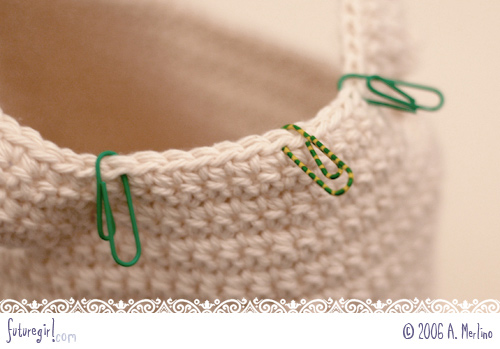 I've been using vinyl-coated paper clips as stitch markers for years. At first it was out of necessity. I just grabbed some while I was crocheting. When that project was done, I tucked them in with my hooks, so I kept using them. I've lost some here and there over the years, so I thought I'd treat myself to some grown-up stitch markers.
I've been using vinyl-coated paper clips as stitch markers for years. At first it was out of necessity. I just grabbed some while I was crocheting. When that project was done, I tucked them in with my hooks, so I kept using them. I've lost some here and there over the years, so I thought I'd treat myself to some grown-up stitch markers.
I was shocked to find out that stitch markers cost about 12 cents apiece for about .003 cents worth of plastic. That's ridiculous. Especially when I can 'find' vinyl-coated paper clips just about anywhere (a.k.a. work) for free. Even though I'm thrifty, I probably would have just plunked down the $3 for 24 stitch markers, but they had little plastic knobbies on them that would catch on the yarn when you mark a stitch. Come on! Couldn't they at least make the edges smooth?
I've decided to embrace my inner cheapskate and add to my paper clip stitch marker stash. For all you thrifty chicks who want some inexpensive, colorful stitch markers, here's how I make them:
After the modifications, I can hold the end with the interior loop facing down and easily thread the interior loop in/under a stitch. Because I closed the exterior loop, the paper clip won't fall off easily.
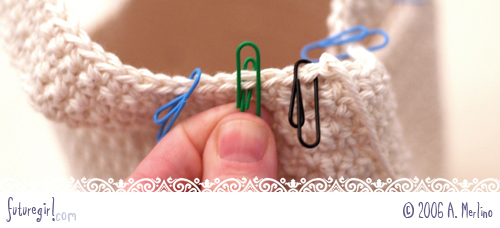
You can find vinyl-coated paper clips in a ton of cool colors and sizes for super-cheap. I even have some funky striped ones. You could use metal ones, but if you are like me and leave projects sitting, sometimes for months, metal ones could rust and mar your yarn. I've never had a problem with the vinyl-coated ones, and I've been using some of them for over 10 years.
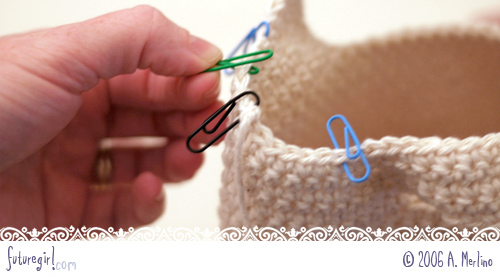
Paper Clip Stitch Markers

I was shocked to find out that stitch markers cost about 12 cents apiece for about .003 cents worth of plastic. That's ridiculous. Especially when I can 'find' vinyl-coated paper clips just about anywhere (a.k.a. work) for free. Even though I'm thrifty, I probably would have just plunked down the $3 for 24 stitch markers, but they had little plastic knobbies on them that would catch on the yarn when you mark a stitch. Come on! Couldn't they at least make the edges smooth?
I've decided to embrace my inner cheapskate and add to my paper clip stitch marker stash. For all you thrifty chicks who want some inexpensive, colorful stitch markers, here's how I make them:
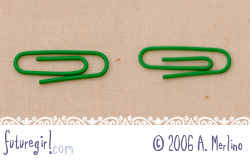 | First, I squish the interior loop so it is tighter. |
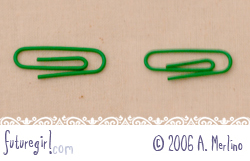 | Second, I bend the interior loop so it's closed. |
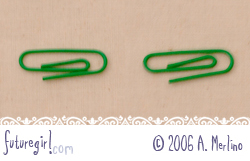 | Third, I angle the interior loop so its tip is centered. |
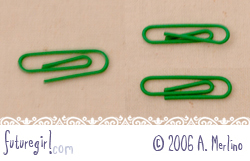 | Fourth, I bend the exterior end in so it rests tightly against the interior loop. This works best when I bend it a little too much inside first, then adjust it so it rests tightly against the interior loop. |
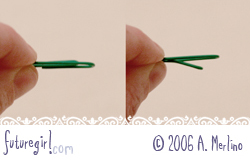 | Fifth, At the point where the exterior end touches the interior loop, I bend the interior loop down a little. |
After the modifications, I can hold the end with the interior loop facing down and easily thread the interior loop in/under a stitch. Because I closed the exterior loop, the paper clip won't fall off easily.

You can find vinyl-coated paper clips in a ton of cool colors and sizes for super-cheap. I even have some funky striped ones. You could use metal ones, but if you are like me and leave projects sitting, sometimes for months, metal ones could rust and mar your yarn. I've never had a problem with the vinyl-coated ones, and I've been using some of them for over 10 years.

Thursday, August 9, 2012
{a thought for Thursday} Home
Books are the plane, and the train, and the road. They are the destination, and the journey. They are home. — Anna Quindlen
Wednesday, August 8, 2012
Tuesday, August 7, 2012
{read: The story of Michael Vick's pit bulls} The Lost Dogs: Michael Vick's Dogs and Their Tale of Rescue and Redemption by Jim Gorant
This story of Michael Vick's pit bulls was tough for me to read. It starts out from the perspective of one of the dogs, and I had to skip those parts in the beginning and skim the rest, which included bloody descriptions of the dog fights, until the book reached the part where the dogs were rescued. I thought things for the dogs would get better, but they were mostly stuck in shelters where they received minimal interaction for months. This further damaged many of them.
For me, the most compelling part was reading how the foster parents, dog rescue groups, and Best Friends Animal Society worked with the dogs to overcome their issues and help them acclimate to the everyday world so that they could be adopted. While some will need to remain at Best Friends sanctuary throughout their lives, they've still made great progress, and their lives are unspeakably better than they would have been otherwise. In fact, at one point the author (a senior editor at Sports Illustrated) says that Vick's dogs weren't very good fighters because he didn't spend enough money to get top-rated dogs, instead choosing to try to pick diamonds in the rough and breed his own champions. However, if the dogs lost, he often tortured and killed them, and those painful deaths likely have been the fate of these dogs.
The book was well-written and Gorant took an even-handed approach to a controversial topic. He did a good job of providing context so the reader understands how pit bulls have become the current demonized dog-of-the-day, following in the footsteps of breeds such as German shepherds, bloodhounds, and Doberman pinschers.
Disclaimer: I bring an animal rescue perspective to this book. I am a volunteer for the Elmbrook Humane Society in Wisconsin and a driver for BRATS, which received a grant from Best Friends. BRATS transports animals from full shelters to rescue groups and shelters that have capacity in Wisconsin.
The Lost Dogs: Michael Vick's Dogs and Their Tale of Rescue and Redemption by Jim Gorant (Gotham, 2012)
My rating: 4 stars
For me, the most compelling part was reading how the foster parents, dog rescue groups, and Best Friends Animal Society worked with the dogs to overcome their issues and help them acclimate to the everyday world so that they could be adopted. While some will need to remain at Best Friends sanctuary throughout their lives, they've still made great progress, and their lives are unspeakably better than they would have been otherwise. In fact, at one point the author (a senior editor at Sports Illustrated) says that Vick's dogs weren't very good fighters because he didn't spend enough money to get top-rated dogs, instead choosing to try to pick diamonds in the rough and breed his own champions. However, if the dogs lost, he often tortured and killed them, and those painful deaths likely have been the fate of these dogs.
The book was well-written and Gorant took an even-handed approach to a controversial topic. He did a good job of providing context so the reader understands how pit bulls have become the current demonized dog-of-the-day, following in the footsteps of breeds such as German shepherds, bloodhounds, and Doberman pinschers.
Disclaimer: I bring an animal rescue perspective to this book. I am a volunteer for the Elmbrook Humane Society in Wisconsin and a driver for BRATS, which received a grant from Best Friends. BRATS transports animals from full shelters to rescue groups and shelters that have capacity in Wisconsin.
The Lost Dogs: Michael Vick's Dogs and Their Tale of Rescue and Redemption by Jim Gorant (Gotham, 2012)
My rating: 4 stars
Monday, August 6, 2012
{crafts} Moroccan Candle Holders from Crème de la Craft
This is a very detailed tutorial that would make a great home decoration, or a fun gift. There are really not too many supplies, some you might even already have on hand. These would be excellent table decorations for a colorful wedding or party. Enjoy... from Crème de la Craft
As much as I love candles, I love decorative candle holders even more. They are the perfect little accessory for any room. With just a bit of paint, transform a plain glass jar or bottle into a vibrant Moroccan lantern. Make them as housewarming gifts or display them at your next outdoor occasion. Either way, they're sure to be a hit!
I guarantee you'll have a good time making these too. Not only were they super simple to make, but I love the way they turned out. Plus, who doesn't like playing with puffy paint? Grab a few empty glass jars and have fun experimenting with different colors and patterns. The possibilities are truly endless. Just follow the steps below to make your very own.


Materials:
• Glass jar, candle holder or bottle
• Transparent glass paint (2 colors)
• Puffy paint/dimensional paint
• Paper plate
• Oven

Steps:
• Pour glass paint into the jar so that the bottom is completely covered.
• Start slowly turning the jar on its side so that the paint begins to spread onto the walls. Add more paint if the paint does not easily swirl around.
• Still holding the jar on its side, pour your second color paint onto the side walls and continue to turn the jar so that all sides of the walls have some paint on them.
• Swirl for a few seconds then turn the jar upside down on the paper plate and watch the paint begin to pour down the sides of the jar. After a few minutes, if the walls are not covered, you may need to add more paint and repeat this step.
• Let the excess paint drip down for about an hour, moving the jar around every 15-20 minutes to prevent it from sticking to the plate. Then, turn the jar right side up and let dry.
• For a durable finish, let dry for a full 48 hours then bake the jar for 30 minutes at 200°F in a non-preheated oven. Allow to cool with the oven door open. (based on instructions from paint manufacturer)
• Using the applicator tip on the dimensional paint bottle, paint your desired pattern onto the bottle. For best results, first sketch a design on a piece of paper and practice using the paint before applying onto the jar.
Have fun and enjoy your new candle holders! Follow along on Facebook and Twitter to keep up with my new DIY projects each week.


Thursday, August 2, 2012
{a thought for Thursday} Guts and pockets
A word is not the same with one writer as with another. One tears it from his guts. The other pulls it out of his overcoat pocket. — Charles Peguy
Subscribe to:
Posts (Atom)
















